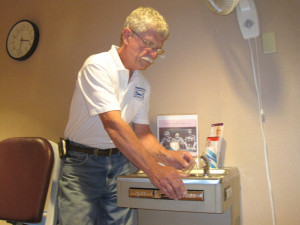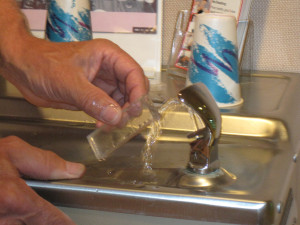Another case for phosphate testing
This detrimental type of scale provides another reason for aquatic professionals to conduct regular phosphate testing and to keep phosphate levels down to prevent scale formation. It is particularly important if phosphate-based metal removal or sequestering products are being used regularly in heated pools or hot tubs where calcium is present. This includes pools in areas with high water hardness levels or where calcium hypochlorite (cal-hypo) (Ca[ClO]2) is regularly used.

In hot tubs, calcium hardness testing (also referred to as total hardness) is important in preventing scale buildup. Calcium hardness is a measurement of the mineral salts present in hot tub water, which include: calcium (Ca), magnesium (Mg), aluminum (Al), iron (Fe), and manganese (Mn). When it comes to hot tub water, 70 to 75 per cent of the total hardness is made up of calcium.
According to the National Swimming Pool Foundation (NSPF), the ideal range for calcium hardness in a hot tub is 150 to 250 parts per million (ppm). Calcium hardness is raised by adding calcium chloride (CaCl2). This chemical predominantly comes in a powder form and must be diluted before it is added to the hot tub water. A liquid version of this chemical is also available for hot tubs, which is much more convenient to use and gets into solution much quicker. However, before adding calcium chloride, the source water should be tested for phosphates first.
High levels of phosphates in fill water, combined with adding calcium chloride, can lead to the formation of calcium scale—especially when the hot tub is being heated. Many products for controlling metals and scale in hot tubs contain phosphoric (H3PO4) or phosphonic acid (C-PO[OR]2), which breakdown to orthophosphate and can potentially combine with the calcium in the water to create calcium scale. Therefore, non-phosphate metal treatment and scale products should be used to prevent this occurrence. Lowering calcium hardness can only be accomplished by draining and replacing the water. Once the water is properly  adjusted, the calcium hardness level will increase over time naturally due to the high evaporation rate in hot tubs. Calcium hardness should be monitored at least monthly. Most manufacturers recommend hot tubs be drained every three to four months.
adjusted, the calcium hardness level will increase over time naturally due to the high evaporation rate in hot tubs. Calcium hardness should be monitored at least monthly. Most manufacturers recommend hot tubs be drained every three to four months.
Hot tub water should also be regularly tested for phosphates, especially if they are tied into a salt system to generate either chlorine (Cl) or bromine (Br). Phosphate levels should be maintained no higher than 250 parts per billion (ppb). Keep in mind, phosphates are a major pollutant to waterways; therefore, hot tubs should always be tested and treated for phosphate removal before each draining.
Phosphate testing and using phosphate removers are recommended for swimming pools to keep resistant algae strains from flourishing in the absence of a chlorine sanitizer or an Environmental Protection Agency (EPA)-registered algaecide. Phosphate removal has become a standard in the swimming pool and hot tub industry as it is a prime nutrient, which algae can use to resist typical chlorine and algaecide treatments. In fact, it has been proven quite successful in these circumstances.
| Hot Tub Scaling |
|---|
| Oil, bather waste and scum buildup above the waterline can attract calcium as part of the scaling process. To prevent this from happening, adding a natural-based clarifier on a weekly basis is recommended. This will trap and filter out contaminants, which add to the unsightly scaling, thus reducing any buildup above the waterline. |
Another reason for keeping phosphate levels down—especially in areas with high water hardness or where calcium hypochlorite and calcium chloride are used in pools and/or hot tubs—is it appears in the orthophosphate calcium scenario. Tri-calcium phosphate is formed from the reaction of orthophosphate with calcium at the heat exchanger. The formation precipitates and is insoluble in water and even more so at higher temperatures. The calcium phosphate scale will adhere to heat exchangers causing damage and failure.
As stated earlier, most metal removal and prevention products (e.g. phosphoric or phosphonic acid) are effective in dealing with certain metal stains; however, they also eventually breakdown to orthophosphate, which accumulate over time. When high levels of orthophosphate are combined with calcium and high temperatures, e.g. at the point of the heat exchanger, the potential for calcium phosphate scale to precipitate and damage the exchanger is extremely high.






